Hangzhou, Nov. 24 (Xinhuanet)-The length of coastline ranks first in China, and the number of islands ranks first in China. This is the natural advantage given to Zhejiang by the ocean, and it also makes the concept of coordinating land and sea and developing marine economy deeply rooted in Zhijiang.
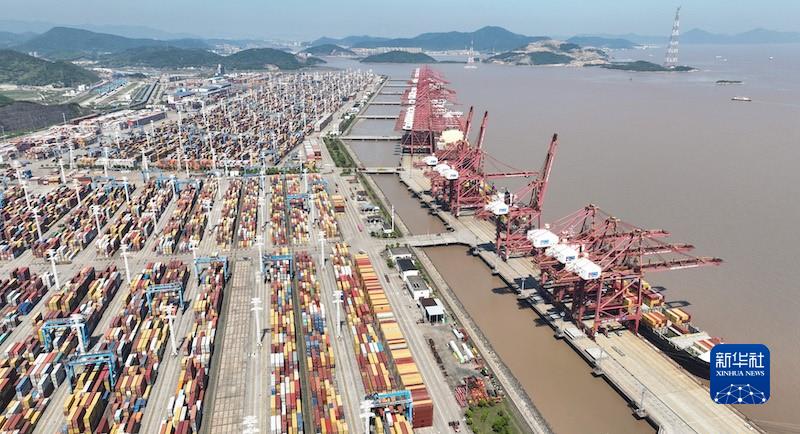
The freighter docked at Chuanshan Port Area of Zhoushan Port in Ningbo to load and unload goods. Xinhua News Agency reporter Weng Yushe
The vast East China Sea stands bravely at the head of the tide.
"Give full play to the advantages of Zhejiang’s mountain and sea resources, vigorously develop the marine economy, promote the leap-forward development of underdeveloped areas, and strive to make the development of marine economy and underdeveloped areas a new growth point of Zhejiang’s economy", which is one of the important contents of the "Eighth Five-Year Strategy" made by the Fourth Plenary Session of the Eleventh Zhejiang Provincial Committee in July 2003. The Zhejiang Ocean Economic Work Conference held in August of the same year officially kicked off Zhejiang’s accelerated construction of a strong marine economy province.
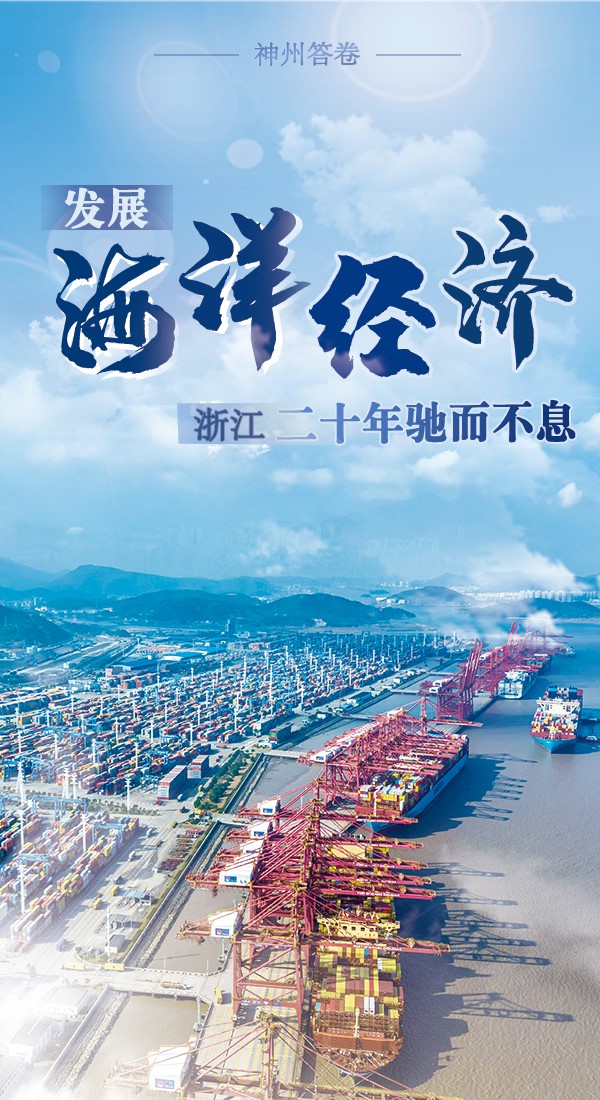
In the past 20 years, Zhejiang has anchored its goals, pursued the road of high-quality development of marine economy, and formed a good pattern of marine economic development with the construction of a world-class marine port as the guide, the construction of a modern marine industrial system as the driving force, and the strengthening of marine science and education and the construction of ecological civilization as the support.
Prosperous to the sea, the blue channel expands its opening up.
More than 1000 years ago, porcelain produced in Longquan, Zhejiang Province was at an important node of the Maritime Silk Road — — Wenzhou Shuomen ancient port changed ships to go to sea and go to the world; Nowadays, Brazilian iron ore, Australian wheat, Argentine corn, Yiwu small commodities and Ningbo mechanical and electrical products all meet in Zhoushan Port, Ningbo. At the side of the huge ship full of imported and exported goods in the middle of the night, steel machines and workers have a tacit understanding.
The port is the hub connecting land and sea, and a series of blue passages on the sea have become the new growth pole of Zhejiang, a small province with land resources. The cargo ships, trucks and busy cranes coming and going show the pulse and surging power of the economy. In 2022, the cargo throughput of Zhoushan Port in Ningbo exceeded 1.25 billion tons, ranking first in the world for 14 consecutive years; The container throughput reached 33.35 million TEUs, ranking third in the world.
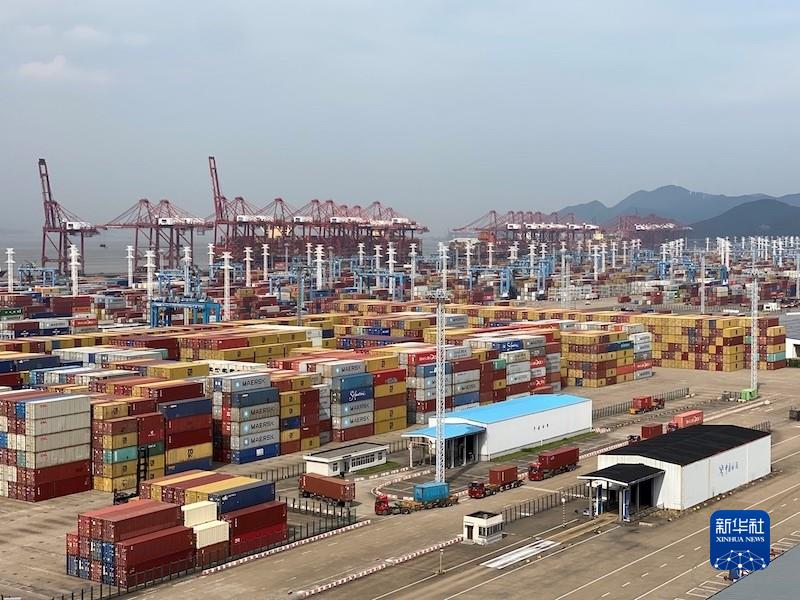
Ningbo Zhoushan Port passes through the dock of Zhoushan Port Area. Xinhua News Agency reporter Wei Yijun photo
Relying on the port and dock logistics, Zhoushan has established a large-scale grain and oil industrial base integrating various service functions such as bulk grain and oil transit logistics, warehousing and processing transactions.
At the Laotangshan Phase III Wharf of Zhoushan International Grain and Oil Industry Park, the bulk carrier Yunlong Feng, carrying 63,000 tons of Brazilian soybeans, is unloading, slimming down and sailing into the Yangtze River for Taizhou, Jiangsu.
Laotangshan Port Area is the largest grain entry port in East China and the throat of grain import in the Yangtze River Basin. At present, there are more than 40 grain and oil processing, warehousing and logistics trade enterprises in the park, with an annual grain processing capacity of 2.8 million tons. In 2022, the import grain transit logistics volume will reach 25 million tons, accounting for 17% of the national imported grain.
From logistics to industry, the development of Zhoushan International Grain and Oil Industrial Park has become a microcosm of Zhejiang’s prosperity to the sea. According to statistics, Zhejiang’s total marine production increased from 58 billion yuan in 2002 to 1,035.5 billion yuan in 2022, with an average annual growth rate of 15.5%, and its marine economic strength ranked first in the country.
In the past 20 years, Zhejiang has made full use of the advantages of port logistics, continuously enlarged the advantages of "sea", continuously accelerated the development of large ports, built large passages, developed large logistics, and formed Ningbo — Zhoushan deep-water port is the hub, Wenzhou, Jiaxing and Taizhou ports are the backbone, and the coastal port system, modern logistics system and industrial system closely related to port logistics are based on various small and medium-sized ports.
In 2021, Zhejiang Province issued the "Fourteenth Five-Year Plan" for the development of marine economy, aiming to cultivate a modern port and shipping logistics service cluster with a level of 100 billion. By 2035, it will form a port-facing industrial cluster with great international influence and build a world-class strong port.
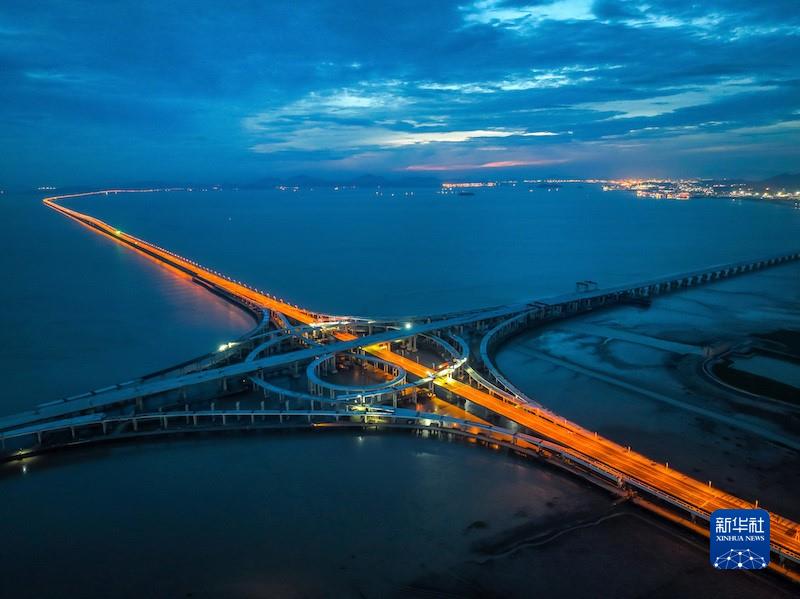
Construction site of girder erection of Jintang Bridge over Binhai Interchange in Ningbo Phase I of Hangzhou-Ningbo Double Track. Xinhuanet issued Yao Feng photo
Waterways are developing, and land is also being opened up. From Zhenhai, Ningbo to Zhoushan, Jintang Bridge, Xihoumen Bridge, Taoyaomen Bridge and Fuchimen Bridge are connected along the way, which makes Zhoushan change the history of "hanging an island on the sea".
On December 29th, 2021, the main channel project of Ningbo Zhoushan Port was completed and opened to traffic. The construction mileage of Zhoushan Liandao Expressway reached 74 kilometers, spanning 8 islands, making it the longest Liandao Expressway and the largest cross-sea bridge group in China. At present, the construction of Ningbo-Zhoushan Railway is also under intense progress, and the completion of this railway will end the history of Zhoushan’s impassable railway.
The land and sea corridor is "one connection and one hundred connections", and major infrastructure projects related to the overall situation have been completed one by one, and the cornerstone supporting the leap-forward development of the blue economy has become more and more stable.
Stronger to the sea, the upgrading of traditional industries.
In the southern waters of Zhoushan Archipelago, an island with a land area of 140 square kilometers — — Liuheng Island is experiencing the upgrading of the traditional marine economic industry.
"Three of the top ten shipyards in the world are gathered in Liuheng Island." Yan Haibin, director of the Shipbuilding Industry Department of Zhoushan Economic and Information Bureau, said that ship repair is an important pillar industry in Zhoushan and a traditional marine economic industry. Zhoushan currently has the capacity to build 7 million deadweight tons and repair 3,000 ships of various types with an annual capacity of more than 10,000 tons. The number of ship repairs for five consecutive years accounts for more than one third of the country.
However, the shipbuilding industry has always been burdened with the reputation of "3D" (Dangerous, Difficult and Dirty). "In the past, the oil pollution in the shipyard was relatively heavy, and the dust generated by the ship repair method of sandblasting and derusting was particularly high." Wang Junting, the head of Zhoushan Xinya Shipbuilding Co., Ltd., which ranks among the top in the world in 2022, said that transformation and upgrading is the only way to continue to be strong.
All shipyards on Liuheng Island have challenged the traditional production and operation methods of ship repair, and comprehensively started the reform of sand blasting and rust removal alternative technology.
Walking by the dock of Zhoushan COSCO Shipping Heavy Industry Co., Ltd., workers can be seen everywhere, either operating the handle or manipulating the crane truck. By controlling the ultra-high pressure water jet derusting equipment through the terminal, there is no rolling dust or pungent smell, and there is no large amount of residual iron sand at the dock bottom, so the dirt and rust attached to the hull of the ship plate are removed.
"The transformation of operation mode has brought greater economic benefits, the unit operation efficiency has increased by nearly three times, and more than 42,000 tons of copper ore have been saved in one year." Zhou Jianhua, general manager of Zhoushan COSCO Shipping Heavy Industry Co., Ltd. said.
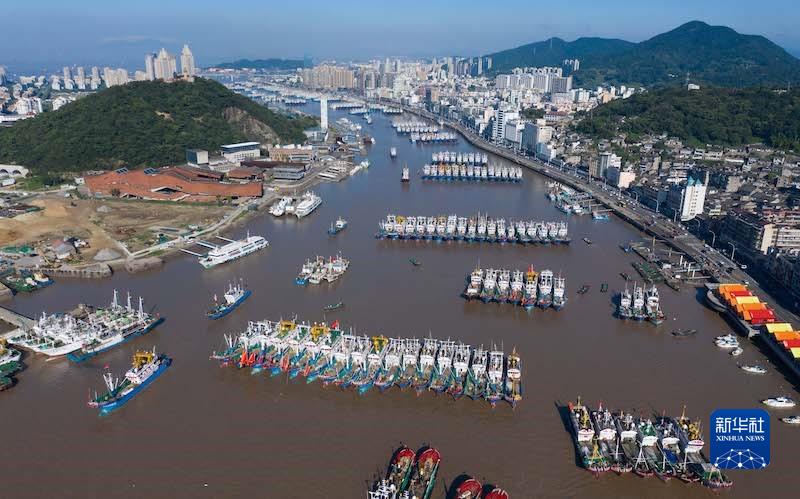
The East China Sea "fished small", while Qian Fan was busy at sea. Xinhua News Agency reporter Xu Yushe
In addition to the shipbuilding industry, traditional industries such as fishing, aquaculture, and port-based industries, which were originally born on the sea, have all ushered in industrial upgrading under the joint action of industrial structure transformation, scientific and technological strength support, and trade policy optimization.
In the past, Zhoushan people who "eat the sea by the sea" often studied how to catch more fish in one net; Nowadays, Zhoushan people are thinking about how to maximize the value of a fish and tap new economic growth points of fisheries.
In the workshop of Zhoushan Evergreen Ocean Food Co., Ltd., the original seafood raw material of about 4,000 yuan per ton was processed into peptide powder of 100,000 yuan per ton through protein peptide extraction technology, which was sold well in the consumer market of health care products.
From longing for the economic benefits of "a net fish" to exploring the multiple added values of "a fish", this is the change brought about by the continuous promotion of marine economic development by the "Eighth Five-Year Plan", and the development of emerging marine industries is changing from "waves and flowers" to a surging trend.
By the end of 2019, the first phase of Zhoushan Green Petrochemical Base, the single industry project with the largest investment in the world, was fully put into operation; On February 24, 2022, Endeavour, the world’s largest single-unit tidal power generator set, was successfully launched in Xiushan Island, Zhoushan, and the continuous operation time of LHD tidal power project remained the first in the world.
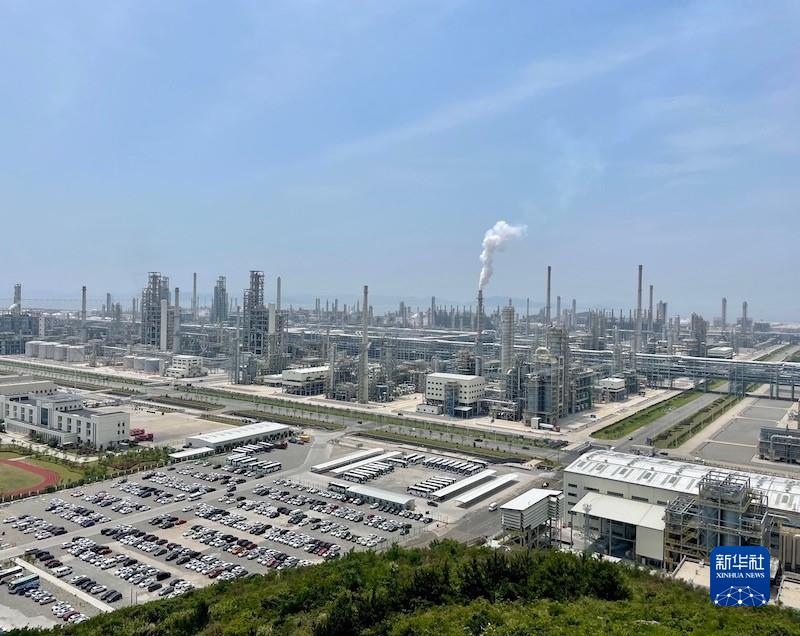
Zhoushan green petrochemical base. Xinhua News Agency reporter Jia Yutian photo
In the past 20 years, the baton of developing marine economy in Zhejiang has been passed on, fully tapping "marine productivity", vigorously developing modern marine industries such as marine equipment, island tourism and offshore fishing, and starting a new engine for the development of blue economy.
"In ‘ August 8th Strategy ’ Under the guidance of, we have gradually clarified the direction of adapting to local conditions and developing the marine economy. It is a long-term systematic project to realize all-round, multi-angle and full-chain transformation and upgrading. In the future, we will continue to anchor the positioning of the new highland of modern marine industry and fully promote the marine economy. A broader new world. " Sun Zhilong, secretary of the Putuo District Party Committee of Zhoushan City, said.
Born to the sea, the sea and people are harmonious and build ecological beauty together.
Driving through the "Moon Ring" Xuanmenwan Bridge in Yuhuan City, the wetland parks on both sides are sparkling, and 256 species of birds will live here, making it one of the best viewing spots for migratory birds along the East China Sea.
In the 1970s, in order to get rid of the real dilemma of lacking arable land and fresh water, Yuhuan people almost completely relied on human resources to level half of the mountain, threw more than 520,000 square stones into the rapids, and built a dam connecting the island and the land. A 12-meter-wide dam has become an important channel to support the rapid development of local economy and society, making small island counties become the top 100 counties in China.
However, the negative impact of the dam has gradually emerged: because the dam blocks the ocean currents, the eutrophication of the water in the bay has increased and the aquatic species resources have shrunk.
It is imperative to withdraw the dam. In 2017, the Yuhuan Municipal Party Committee and the Municipal Government proposed a plan to build a bridge and remove the dam; In June, 2021, Xuanmenwan Bridge, which was built in parallel with the dam, was officially opened to traffic, and the two-way six-lane traffic greatly improved the traffic efficiency.
Liu Shijin, a citizen of Yuhuan who participated in the dam construction survey that year, said that the dam was built for development in the past, but now it is withdrawn for longer-term development. "Leisure citizens and tourists can be seen everywhere along the wetland coast, and homestay camping is very prosperous." Statistics show that this year’s "May 1" and "Eleventh" holidays, the "upgraded" Xuanmen Bay Scenic Area has received more than 70,000 tourists.
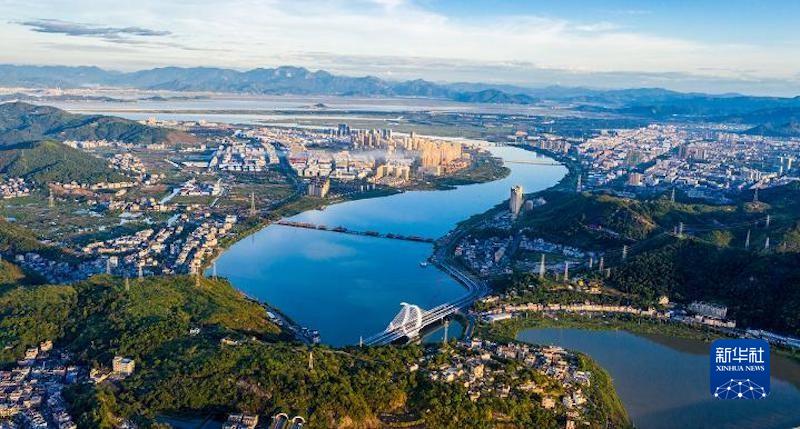
Scenery on both sides of Xuanmen Bay. Xinhuanet issued Yuhuan Municipal Committee Propaganda Department for the picture
In line with the changing thinking of the times, Yuhuan story is not an isolated case in Zhejiang in the choice of improving the relationship between people and sea. At the end of 2020, the head of Lingni levee was demolished in Dongtou, Wenzhou to make way for migratory fish; At the beginning of 2022, Fenghua, Ningbo, cleared the beach and returned the mackerel to a stable home … … Along the coastline of more than 6,700 kilometers, the practice of harmonious development of human and sea is everywhere in Zhejiang.
In July, 2020, Wenzhou Dongtou Blue Bay Renovation Action Project was selected as the only case of marine ecological restoration among the top ten cases by the Ministry of Natural Resources. The 302 islands in Dongtou are also continuously exploring the transformation channel of the "two mountains concept" in the blue sea.
Chen Xuyang, director of Dongtou Branch of Wenzhou Ecological Environment Bureau, Zhejiang Province, said that not long ago, six financial institutions led by China Development Bank signed a loan contract of 2.3 billion yuan with Dongtou District of Wenzhou in 2023, marking the settlement of the first batch of EOD projects of marine ecological restoration in China (eco-environment-oriented development model), which solved the problems of financing difficulties in previous eco-environmental governance projects, and promoted industrial development through governance, which will further amplify the attraction of "sea gardens".
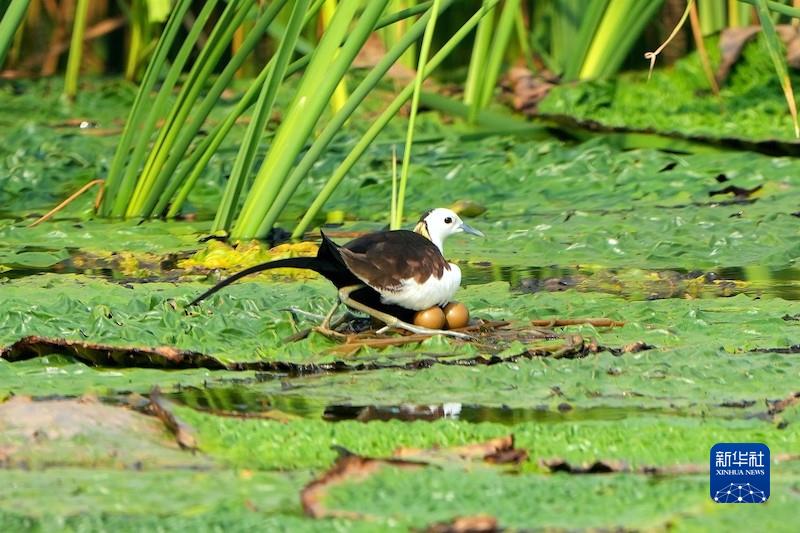
Pheasants in Hangzhou Bay Wetland Park. Photo courtesy of Zhejiang Hangzhou Bay National Wetland Park by Xinhuanet
From demanding space and resources from the ocean to building a harmonious concept of ocean development, Zhejiang has put ecological civilization construction in a prominent position, from point to point, land and sea linkage, taking hard measures, seeking practical results, strengthening law enforcement and supervision of sea islands, continuously organizing and implementing the "Blue Bay" rectification action and coastal protection and restoration projects, and building a blue ecological hard barrier.
Since 2020, Zhejiang has taken the lead in establishing the first provincial comprehensive evaluation index system for marine ecology; Take the lead in controlling the total amount of pollutants entering the sea and piloting the marine ecological red line system; Implement the establishment of a global marine ecological construction demonstration zone & HELIP; …
In order to protect marine ecology at a higher level, up to now, Zhejiang has formed "a book", "a picture" and "a table" of ecological risks at the provincial, municipal and county levels, comprehensively grasping the ecological background and forming a new pattern of marine ecological protection and restoration.
Planning: Wu Huanqing, Chu Xuejun, Qian Tong
Producer: Yuan Zhenyu and Zhou Hongjun.
Execution: Liao Xiaohua, Wan Fang
Coordinator: Weng Jing and Ma Jiang.
Text reporters: Yuan Zhenyu, Huang Xiao, Wu Shuaishuai, Lin Guangyao
Poster design: Guo Yanting
Editor: Wang Ying, Wang Ya, Guo Yanting
Xinhua News Agency Zhejiang Branch Xinhuanet jointly produced.